Anna Geiger's Blog, page 27
April 18, 2021
The difference between balanced and structured literacy
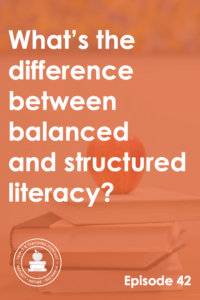
It���s time to take a good look at what we���re doing when we teach children to read. I considered myself a ���balanced literacy��� teacher for many years. It���s the approach I learned in graduate school, the approach I used as a classroom teacher, and the approach I (used to) teach on my website and in my online course.
However, after a great deal of research into the science of reading, I now see things differently.��I now advocate a��structured literacy��approach to reading instruction.
Listen to the episode hereFull episode transcriptTranscript
Download
New Tab
This podcast episode is an audio version of my blog post: What is the difference between balanced and structured literacy?
Balanced and structured literacy are two different approaches to teaching reading. They have things in common, but when they���re referenced in the same breath they���re usually pitted against each other.
I considered myself a ���balanced literacy��� teacher for many years. It���s the approach I learned in graduate school, the approach I used as a classroom teacher, and the approach I (used to) teach on my website and in my online course. However, after a great deal of research into the science of reading, I now see things differently.
I now advocate a structured literacy approach to reading instruction.
This isn���t to say that I did every single thing wrong as a balanced literacy teacher, or that balanced literacy teachers today aren���t getting anything right. Nor do I think that we have to throw away everything with the balanced literacy label. But it���s time to take a good look at what we���re doing when we teach children to read.
What���s the difference between balanced and structured literacy?
Let���s start with a definition of balanced literacy.
Balanced literacy is a philosophical orientation that assumes that reading and writing achievement are developed through instruction and support in multiple environments using various approaches that differ by level of teacher support and child control.
(Fountas & Pinnell ��� Guided Reading: Good First Teaching for All Ages)
The fact is, if you ask twenty different balanced literacy teachers to define balanced literacy, you will likely get twenty different definitions. It���s just not well-defined. But most balanced literacy teachers will say (as I did) that they teach reading in a way that meets everyone���s individual needs while also promoting a love of reading.
Balanced literacy came about in the late 90���s as an answer to the whole language and phonics debate. The hope was that it would provide a much-needed compromise by using the best of both approaches. To many people, though, balanced literacy is a dirty word.
What went wrong? Why is structured literacy now coming into favor? Many will tell you that it���s just another pendulum swing. I think it���s much deeper than that.
Let���s start with a definition.
���The term ���Structured Literacy��� is not designed to replace Orton Gillingham, Multi-Sensory or other terms in common use. It is an umbrella term designed to describe all of the programs that teach reading in essentially the same way.���
(Hal Malchow ��� International Dyslexia Association)
I used to be a STRONG balanced literacy advocate
Believe me, I never thought I���d be writing an article comparing balanced and structured literacy. I believed in balanced literacy with all of my heart.
I became irritated very angry when I read articles that slammed balanced literacy. The articles said I wasn���t teaching phonics (I was). The articles said I was teaching guessing (I felt that I was teaching my students to be strategic).
The articles said I should be doing more explicit instruction (I felt that my mini-lessons served that purpose just as well as a 30-minute whole class lesson that would likely bore half my class).
The articles criticized my lack of a structured curriculum (I felt that I knew my students much better than a scripted curriculum any day). The articles said balanced literacy didn���t work. I had plenty of anecdotal evidence that it did.
Here���s the thing. And this is something we all need to take note of.
Balanced literacy works for some children. Many children DO learn to read without a lot of explicit instruction.
But it doesn���t work for others.
Explicit instruction is good for all children. It���s absolutely essential for many of them.
In other words? If we use a balanced literacy approach, we will not reach all of our students.
Here���s the key difference between balanced and structured literacy
Balanced literacy is centered around activities that surround children with quality literature and promote a love of reading, whereas structured literacy teaches the structure of language through explicit, systematic, sequential instruction.
Balanced literacy teachers typically teach the essential components of reading (phonological awareness, phonics, fluency, comprehension, and vocabulary) through the following structures: read aloud, shared reading, guided reading, and independent reading.
Teachers tend to be more focused on the activities themselves than on the skills.
On the other hand, structured literacy teachers may include read aloud, shared reading, small group instruction, and independent reading in their days, but they are focused less on activities and more on the structure of language: phonology, sound-symbol correspondences, syllables, morphology, syntax, and semantics.
A summary of the differences between balanced and structured literacy
I know that not everyone will agree with my characterizations in the following chart, but this is how I see it. Let���s tackle the differences one by one.
Difference #1: In balanced literacy, we typically see a haphazard approach to phonemic awareness instruction. Structured literacy includes systematic, sequential instruction in phonemic awareness.
Through the work of David Kilpatrick, we���ve learned that phonemic awareness may very well be the missing key for struggling readers. It���s essential that we give daily lessons in phonemic awareness.
Our students need lessons in phoneme isolation, blending, segmenting, and manipulation.
If you���re a balanced literacy teacher, an important change you can make is to do ten minutes of phonemic awareness instruction every day.
Difference #2: In balanced literacy, phonics lessons are typically quite short and may not follow a scope and sequence. In structured literacy, phonics is taught through an explicit, systematic and sequential approach (usually through a purchased curriculum).
As a new first grade teacher, I had to use a scripted phonics program that I HATED.
It moved too quickly for my low readers, and it was immensely boring for my strong ones.
And it took way too much time out of our school day.
I received permission to ditch that program in my second year of teaching first grade, and from then on I had a very ���I���ll teach it when you need it��� approach to phonics.
I���m fully aware that many balanced teachers DO have a structured approach to teaching phonics, and I say hurray for them!
But it���s not the norm.
A strong phonics lesson is 20-30 minutes long and has most, if not all, of the following components: a phonemic awareness warm-up that connects to the phonics skill, explicit introduction of the new sound-spelling relationship, blending practice, word building, practice reading decodable text, and guided writing practice. (And while there are still pretty boring phonics programs out there, there are many hands-on programs that allow you to meet multiple levels in one classroom.)
Difference #3: Balanced literacy teaches rote memorization of high frequency words. In structured literacy, high frequency words are taught according to their phonics patterns, and even irregular words are taught explicitly.
For years I thought it made perfect sense to teach kids to memorize long lists of high frequency words. That���s why I created a whole series of sight word books that taught high frequency words through repeated exposure.
I���ve since removed those books from the website because I���ve learned that this isn���t the best approach for teaching high frequency words.
After all, kids don���t store thousands of whole words in their brains. That���s not how the brain learns to read.
A better approach is to teach a small number of ���sight words��� to get kids started (such as the and is), and to teach the rest when you teach their related phonics patterns.
As for irregular words, you can still be explicit about teaching them.
Difference #4: In a balanced literacy classroom, beginning readers read leveled texts using the three-cueing system. In a structured literacy classroom, early readers read decodable texts that include already-learned phonics patterns.
This difference right here is the one that made me realize I could no longer support a balanced literacy approach.
If you consider yourself a balanced literacy teacher and do not teach your students to solve words using the picture, context clues, first letter (and anything else other than sounding out the word), please comment below ��� because as far as I know this type of teacher does not exist.
I never EVER thought I���d denounce three-cueing, but after studying the science of reading I can no longer support it.
If this makes you bristle (believe me, I know how you feel), I encourage you to listen to my podcast episode, What���s wrong with 3-cueing?
For years I resisted decodable books because I was sure they would kill a love of reading before it could start.
After all, wasn���t every decodable book boring, stilted, and nonsensical?
Turns out ��� I was wrong! There are actually many quality decodable books just waiting for you to discover them.
Difference #5: In a balanced literacy classroom, there is typically a greater focus on the meaning of the text rather than on the accuracy of what is read. Structured literacy teachers correct misread words; they encourage their students to sound them out.
This sounds crazy, but for years I believed that ���sound it out��� should only be said as a last resort.
I thought that it was much better to ask my students to consider what made sense ��� because isn���t reading all about comprehension?
(Well, yes it is, but reading comprehension is a product of decoding and language comprehension. See this podcast: What the science of reading is based on)
I think that the traditional use of running records leads many balanced literacy teachers to believe that getting the general meaning right is more important than sounding out every single word.
For that reason, I recommend rethinking running records.
Difference #6: Balanced literacy teachers believe that students get better at reading by reading. Structured literacy teachers will tell you that students get better at reading by learning and practicing the code.
This one is a little tricky. Kids need to practice reading, whether or not they���re in a balanced literacy classroom.
But first they need to learn to decode the words, which they learn through explicit instruction.
As a balanced literacy teacher, I had my students fill their bags with ���just right books��� (i.e. leveled books that required them to use three-cueing to solve the words) because I thought that they more they ���read,��� the more they���d pick it up.
Now I know that after kids have developed the habit of connecting the phonemes to the graphemes (sounding out words), reading practice will help them orthographically map the words (i.e. store them in their brains for future, instant retrieval).
Difference #7: Balanced literacy teachers believe that the point of reading instruction is to get children to love reading. Structured literacy teachers believe that the point of reading instruction is to teach children to read.
This is NOT to say that balanced literacy teachers aren���t concerned with teaching children to read.
Of course they are.
This is NOT to say that structured literacy teachers don���t want children to love reading.
Of course they do.
But structured literacy teachers understand something I didn���t ���get��� for a long time.
Success breeds motivation. (That���s a quote from Anita Archer in a podcast episode from The Reading League.)
When you teach children to read, and they see that they can do it ��� that they are actually pulling those words off the page by connecting the sounds to the letters, THAT is what gets them excited about reading.
This may be my longest blog post ever, so it���s time to wrap it up. Before I do, though, I want to address a few criticisms of each approach.
Critics of balanced literacy say that it���s haphazard, teaches bad habits, and puts the cart before the horse.
These criticisms were immensely insulting to me not so many months ago. But now I get it. By not teaching skills in an explicit, systematic way, I was missing many of them.
By teaching my students to use the picture or context to solve words, I was teaching them habits that would not serve them when they got into third grade (and the harder texts that came with it).
By thinking that we needed to focus FIRST on comprehension, I was putting the cart before the horse. (I was expecting them to comprehend what they couldn���t even read!) I had to teach them decoding first. Once their decoding became more automatic, they could develop fluency. Then comprehension came into play.
Critics of structured literacy say it���s boring and drill-and-kill. They claim that it stifles fluency, ignores comprehension, and kills the love of reading.
I���m not making this up. These were my criticisms of structured literacy.
Now I know that explicit, systematic teaching does not have to be boring. When a knowledgeable, engaging teacher combines the art of teaching with the science of reading, joyful learning can result.
Now I know that while it���s a little painful to hear kids sounding out every word (instead of flying through predictable texts), it���s a necessary part of the process. I learned that we can focus on comprehension when a child can sound out words quickly enough to remember what was read. Until that time, we focus on comprehension through interactive read alouds.
And through conversations with a principal, school psychologist, and many former balanced literacy teachers, I finally get it.
We���ve got to teach kids to read before they can love it.
Scroll back to top
Sign up to receive email updates
Enter your name and email address below and I'll send you periodic updates about the podcast.
powered by
Related linksOriginal blog post: What’s the difference between balanced and structured literacy? The Reading League podcast episode: Interview with Anita Archer
The post The difference between balanced and structured literacy appeared first on The Measured Mom.
What is sound-symbol association in a structured literacy classroom?
It’s time for another post in our structured literacy series! Today we’ll look at teaching sound-symbol association.
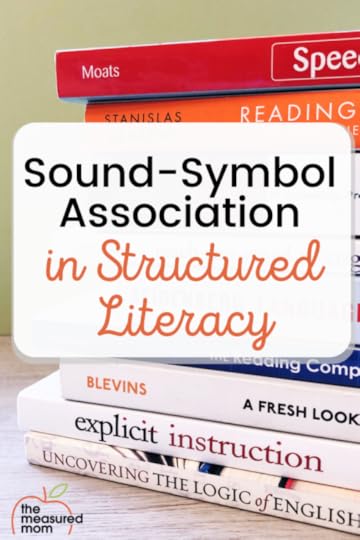
Have you been following along with our series about structured literacy?
We’ve defined structured literacy, compared it to balanced literacy, and explained how to teach phonology in a structured literacy classroom.
Today we’re going for the big one … sound-symbol association.
What is sound-symbol association?We’re teaching kids to associate sounds (phonemes) with symbols (graphemes).
In other words?
Phonics.
Like it or not, phonics has been a hot button topic for decades.
These days, nearly everyone agrees that kids need phonics. We just disagree about the why, what, when, and how.Let’s tackle the “why” first. Why do we need to teach phonics? Don’t some people learn to read by reading whole words?
Here’s the thing.
Why we need to teach phonicsSkilled readers use phonics to read words.
This isn’t intuitive.
I know it feels like you’re reading words as wholes as you breeze through this blog post. But if you were truly doing that with everything you read, you’d have images of over 30,000 words in your brain at once. Scientists tell us that’s just not possible.1
(And even if it were possible, how could we explain that you read the same words in different fonts, or in miXeD CAses? You’d need images of all of those in your brain too.)2
Scientists tell us that skilled readers are actually (very, very rapidly) matching the sounds to the letters as they read. While we may refer to context to help us define a word or understand the text, we solve words by matching the phonemes to the graphemes (i.e., we use phonics).
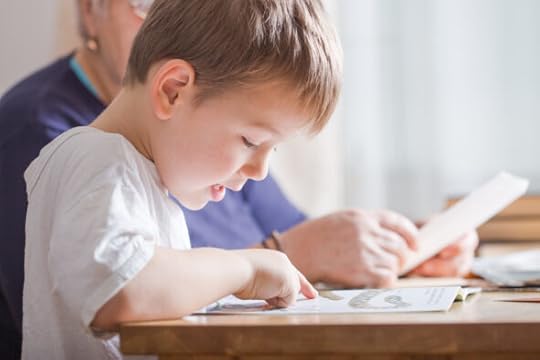
This means that even that rare number of people (around 5%) who learn to read without direct instruction3 are using phonics. They just figured it out on their own.
It helps to know how the brain learns to read.
I published a whole podcast episode about this, but here’s the quick version: our brains are not “hard-wired” to read. We have to train them to read. We do this by helping different parts of the brain work together to allow us to sound out words and permanently “map” them into our sight word vocabulary.
What phonics skills do kids need to learn?As we stated earlier in this series, a key feature of structured literacy is that instruction is systematic, sequential, and explicit.
This means that we need to know the order that we’re going to teach phonics skills. And we’re going to follow it. (This doesn’t mean we can’t differentiate as needed, but we’re not going to be haphazard about phonics instruction.)
A suggested sequence for teaching phonics skills
There is no universal sequence for teaching phonics skills; every program is different. There is not one right way.
Likely, you have a phonics curriculum. You should follow its scope and sequence.
But if you’re looking for ideas, here is a possible order.
Consonants and short vowel sounds … taught in an order that allows children to start reading short words as soon as possibleCVC wordsBeginning digraphs (thin, ship, chat, etc.)Double final consonants (fill, kiss, etc.)Beginning and ending blends (frog, stun, band, dust, etc.)Simple suffixes (cats, bigger)CVCE words (bake, dime, etc.)Y as a vowel (fly)R-controlled vowels (cart, fork, bird, fur, germ)Long vowel teams (weed, rain, toad, etc.)Diphthongs and other long vowel patterns (saw, boy, haul, coin)Prefixes and suffixes (redid, unpack, careless, sitting)6 syllable types (open, closed, silent e, vowel team, r-controlled, consonant+le)When do kids need phonics instruction?Kids need phonics instruction after they have at least some level of phonemic awareness. They must understand how to break words apart into their individual sounds (phonemes) and how to blend those phonemes to make words.
Phonics will not work if kids do not have phonemic awareness.
Assuming kids have the necessary pre-reading skills, you can start teaching phonics as young as preschool.
I always taught my kids all their letters and sounds before teaching them to read.
But if your students have phonemic awareness, you can go ahead and teach beginning reading while you teach the letters and sounds.
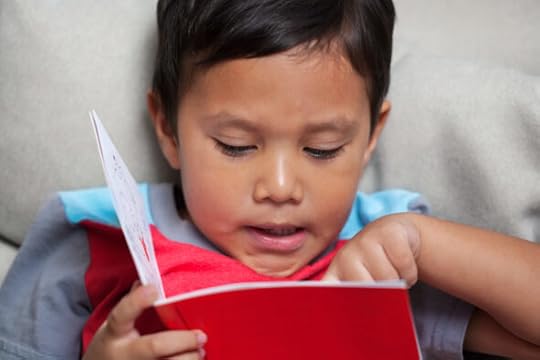
Just make sure you teach the sounds in an order that allows your learners to read words quickly (for example, teach the short sound of a early on so they can read simple three-letter words).
Kids definitely need structured phonics lessons in kindergarten, first, and second grade. Older, struggling readers will need focused phonics in third grade and beyond.
How should we teach phonics?We teach daily focused phonics lessons that look something like this, as recommended by Wiley Blevins.4
Begin with review. Have children reread a passage or brief story from a previous lesson.Do quick phonemic awareness exercises.Directly teach the new sound/spelling relationshipModel how to blend words with the new sound-spelling and give children practice blending words.Have children build words using letter cards or magnetic letters.Provide decodable text with words that are decodable based on sound-spellings that have been previously taught.Dictate words using the new and previously learned sound-spellings for children to write.Did you catch that last bullet?
We want to make sure that our phonics instruction includes both decoding and encoding. Encoding is the spelling piece. It’s helping kids break words apart into sounds, and it’s a crucial part of phonics instruction in a structured literacy classroom.Final thoughtsIn today’s post we discussed why we need to teach phonics. We looked at a possible sequence for teaching phonics skills, noted that children need phonics instruction in K-2 (and perhaps later), and we looked at the recommended pieces of a phonics lesson.
Stay tuned for the rest of our series!
ReferencesPart 1 Part 2 Part 3 Part 4 Coming soon Coming soon Coming soon
“How We Remember Words and Why Some Children Don’t” presentation by David KilpatrickNancy Young’s Ladder of Reading Equipped for Reading Success , by David Kilpatrick Phonics from A to Z , by Wiley Blevins
The post What is sound-symbol association in a structured literacy classroom? appeared first on The Measured Mom.
April 11, 2021
Do’s and don’ts for using decodable texts with beginning readers
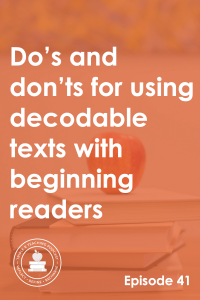
For years I thought that decodable texts were a necessary evil … I thought they were boring, stilted, and nonsensical.����Now I know that quality decodable books are vital for helping young learners build a strong foundation. The good news is that there are many wonderful decodable books, and more are being published all the time. Listen to find out my top tips for choosing and using decodable books.
Listen to the episode hereFull episode transcriptTranscript
Download
New Tab
Hello, Anna Geiger here. I'm the creator of The Measured Mom website, The Measured Mom Plus membership site, two online courses (Teaching Every Reader and Teaching Every Writer), as well as this podcast, Triple R Teaching. You are listening to Episode 41: Dos and Don'ts for Using Decodable Texts with Beginning Readers.
So, first off, let's talk about what decodable texts are. We talked about this a little bit, I believe, in our last episode about decodable and leveled texts. Just as a review, a decodable text is a text that is written for children to practice their phonics knowledge, so the words are able to be sounded out because they include the patterns the child has already learned.
Now, one text that's decodable for a certain child may not be decodable for another child, because whether or not a text is decodable depends on the phonics knowledge that you have. For example, some children may be reading a book that has CVC words and blends and digraphs, like my five-year-old. He can read those books, and for him, those books are decodable. But he could not be reading a book that has CVCE words in it, for example, and call that decodable because I haven't taught him that pattern. The same thing is true for more advanced long vowel patterns - he knows a handful, but not very many. Whereas if a child is in late first grade or the middle of first grade, that book will likely be decodable because they've learned those phonics patterns.
So just because a book is decodable doesn't mean it's the right fit for a child. It depends on the phonics patterns that they have learned.
I'm going to talk to you now a little bit about the authenticity of decodable books. One reason that I fought against using decodable books for a long time was because I thought they were inauthentic, and that meant I couldn't use them. Authenticity has to do with why the books were written, and it's not a good or a bad thing. Here's a quote from Spelfabet, and I'm going to link to that blog post in the show notes. The author writes, "In linguistics and education, an 'authentic text' is a text written for any purpose other than teaching/learning about language. The word 'authentic' doesn���t have its usual meaning in this context, nor its pejorative opposite 'inauthentic'. It���s not a value-judgement. The opposite of an authentic text is a text written for the purpose of language-teaching. This is a valid reason to write a text. Authentic texts thus aren���t superior to language-teaching texts, they just serve a different purpose."
So what's my point? My point is that decodable texts are written for a purpose. They're not just written because an author wanted to tell a story and get it published. They're written to help beginning readers. So we have to realize that decodable texts have their place, but they're not something that kids are going to read forever and ever. We're using them at the beginning. I've heard some people refer to decodable texts as training wheels, and when kids don't need them anymore, we let them go. But they serve a very useful purpose in the beginning.
So now that we've got that out of the way, what are decodable texts? Here's my first "DO" for decodable texts and that is to use them! That feels rather "duh," why would I even have to say that you need to use decodable texts? But the reason is because for a lot of years, I didn't want to use them at all. The reason why I didn't like using decodable texts was because I felt that they killed a love of reading before it could even begin, and I felt that they didn't tell good stories and they would hurt comprehension. You see what I was using were leveled books, which I talked about in our last episode. In leveled books, there's typically a predictable pattern, kids can use the pictures to solve the words, they can use context, and they tend to "read" more quickly. To me, that felt like authentic reading because as they were "reading the book," it was very smooth and it sounded fluent because with those predictable patterns, they could go rather quickly.
So the book might say, "I have a hat. I have a book," and since they figured out that pattern very quickly, the reading was very smooth. When I heard kids read decodable books where they had to sound out every single word, "I /h/-/a/-/v/ a /c/-/a/-/t/," to me, that was very painful. I thought that it just made me feel really bad to hear kids doing that. It made me think, "Oh, who's going to want to read when it's so much work!?" So I really fought against decodable books for many years because I felt that they were not what beginning readers needed to use. Especially because it took them so long to get to the end of the sentence, how could they even understand or remember what they'd read at the beginning? I was getting a few things backward and that's probably for another episode, but the fact is decodable books are valuable and here's three reasons I want to give you for why you should use them with your students.
Number one, they train your beginning readers to focus on the letters in the words. We have talked a lot about this in the science of reading series. We talked about how in the left side of the brain, there are some connections that we need to make, and those connections can't be made unless we give kids practice connecting the phonemes to the graphemes. In other words, sounding it out. If we're giving them lots of books where they don't have to sound out words, where they can just use the picture or guess based on the context, then we're not letting those connections take place. Remember what we're after here. We're not just after them solving the word in the moment, but we're after them storing that word for future retrieval - not as a full picture, but to have it orthographically mapped. Orthographically mapped means you've connected the sounds to the letters enough times that that word is automatic for you, and that every time you see it, it's a new sight word. It's a word you can just read automatically by sight. So we've got to give them practice sounding out, and that's what decodable texts are good for.
Another reason, similarly, that you should use decodable texts with beginning readers is it ensures that they can't use the pictures or context clues to solve the words. I used to hate it when people would say that using context or picture cues was guessing! I hated that because, to me, it wasn't guessing at all, it was being strategic! When I had my kids do that, I thought, "Well, they're using all the strategies that are available to them. They're using the picture, they're thinking about what would make sense, they're skipping and coming back to it, and they're thinking about what would make sense grammatically. They're being problem-solvers and isn't that what we want?"
Well, when you teach kids to read using decodable books, suddenly, as you get into it, you realize, "Ah, this is way more efficient." Once they are good at sounding out words, it's way more efficient to read using phonics than trying to use clues on the page. When we teach them to use clues on the page as their first strategy, we're bypassing what they really need to be doing to get those words in their brains and orthographically map them.
So for me, it was understanding that yes, they can figure out a lot of the words using pictures and context clues, but that is not a good strategy because it's going to make them hit a wall in the future. For many kids, sure, they can solve words using the pictures and the context, but when they get to third grade and those supports aren't there anymore, suddenly they're left in a conundrum because now they don't have strategies to solve those words because their phonics skills aren't strong enough. Decodable books ensure that kids are not guessing because they have to use those letters to solve the words.
And finally, quality decodable books can help students have success with reading, and by extension, learn to love it. To me, this was backwards for a while. I thought, "Well, I can't get kids to love reading if they're using decodable books, I have to use leveled texts because those texts have better pictures. They have better stories, and so because of that, kids will learn to love reading." But what I didn't understand was that success breeds enjoyment. When kids know that they are actually solving those words on the page, and they feel themselves actually connecting the sounds to the letters, and they know that they're REALLY reading those words - they're not guessing, that's where the enjoyment comes from! When they can see that, yes, they can do it, then enjoyment can follow.
With my little guy, my youngest, I've been teaching him to read with just decodable books. This is different than I did with all my other kids. He loves reading! He loves it because he knows he's really doing it. He's picked up his decodable books all on his own from the very beginning. A week after we started using decodable books, he was picking them up and sitting on the couch and reading, "The cat has a hat." He was excited! He knew that he was doing it! So don't think that decodable books will kill a love of reading.
Now, the type of books you use is important and we'll get to that, but I want you to know that when kids really are reading and know they can do it, that's where the love of reading can come from. All right, that was long. That was my first "DO," which was, DO use decodable books.
My next one is DON'T use decodable books that you personally don't like. I really think that if you are not on board with your reading program or reading materials, it's going to show. First of all, you have to be convinced that decodable books are valuable, which really to do that, you should listen to the other episodes in the science of reading series. But once you believe that, you need to find a decodable books that you're excited about and that you believe your students will be excited about. I say this because years ago, okay, about 20 years ago, in my first year of teaching first grade (it wasn't my first year of teaching, but it was my first year in a first grade classroom), I had used a phonics program that I really, really, really did not like. I think even now with all I know, I still would not like the program. Thankfully they've improved it. I checked their website, I'm not going to name it, but it looks a lot better than what it did 20 years ago.
But man, those decodable books were awful! They were all black and white, which does not have to be a problem, but they were little throw-away books, and that's all we had. The only decodable texts we had were these little throw-away books that were SO stilted in their language. It wasn't connected to anything at all that my students would be familiar with because they were just trying to jam in words they could sound out. No one got enjoyment out of those books. It was just something to check off our to-do list. At best, I thought of them as a necessary evil.
I don't want that for you. I don't want that for your students. The good news is there are so many good decodable books out there that you don't have to resort to those "necessary evil" decodable books. So that's my next "DO," is DO choose quality decodable books.
So what makes a quality decodable book? Well, first of all, I want to talk about something from this book by author Wiley Blevins, it's a new book called "Choosing and Using Decodable Texts." In this book, he references the government document "Becoming a Nation of Readers" from 1985. There, they said that these criteria should be present in a quality decodable text:
"#1: Comprehensible. The stories should make sense and follow natural sounding English spoken and written patterns. No sentences should be in these stories that you, as a proficient speaker and reader of English, have not uttered, written, or read. Vocabulary must be understandable. Words must be derived primarily from children's speaking and listening vocabularies.
"#2: Instructive. The majority of words (you should know that there is disagreement as to what percentage of the words should be decodable) must be decodable based on the sound spellings previously taught. In addition, there should be enough words with the new target phonics skill for children to get ample practice decoding words with that skill. There must be a strong connection between instruction and text.
"#3: Engaging. These connected decodable texts must be engaging enough for children to want to read them again and again. Children need to revisit these texts to develop fluency and increase reading rate. The texts should also be worth writing and talking about. In early texts, some of the engagement and discussion will be derived from the high quality photos and illustrations, but the text must support them."
I love that because, honestly, I've seen some people that have said, well, if it's decodable, then we use it, it's great. I don't think that's true. There are some really junky decodable books out there. So how do you know what's good? How do you know what to find?
Well, first of all, I think a given is that the decodable text has the patterns you want kids to practice. That's a given. So let's assume the text has that because they all do, right? That's the definition of a decodable book.
But how do you choose the good from the bad? I think your decodable books need to tell a story if they're pretending to tell a story. Some books are just collections of sentences, and that doesn't have to be bad, but if it's supposed to be a story, it better be a story! How do you know if it's a story? The answer is if you can ask questions about it. I've had some decodable books that I've had my little guy try or I've read before giving to him, and I've thought, "I'm not going to use these because they don't make any sense at all. I can't even think of a question to ask because it goes all over the place." They're so anxious to use these decodable words that they don't even think about whether it makes sense! A decodable text should make sense.
I'm going to give you an example. This is from Whole Phonics, and I really like these. I would say they're a little advanced for very beginning readers because there are a lot of words on a page, but as kids advance - so after a few weeks or a month or so of reading decodable texts, they may be ready for some of these. This book, my little guy has read many, many times. It's about a dad and his kids and their friend. They go to the beach and they're playing tag in the ocean, and then something scary happens. It says, "Ah! A fin! The fin will tag dad!" And then of course, the fin is their friend who's a pig dressed up as a shark. They get a little angry with him. It's a really cute story, and you can certainly ask questions about it. And that I think is valuable - a story that has a problem and solution.
Here's another example. These are really, really good. They are the Half-Pint Kids books. I definitely recommend these! At first glance, the pictures might not be your favorite, but I promise you, once you get into using these, you're going to love them. So this is very simple; it's just two kids who are dressed up as astronauts. They have a big job. Their job is going into space. They're getting their seat belts on, lifting off, and off they go. They'll do their job of going into space. It's very, very simple, and yet you could still ask questions. Just listen to the questions in the back of the book. "How do you know Kim and Ross are American astronauts? Why are they going into outer space? What kind of jobs might they perform on the space shuttle? What must they do before the rockets are launched? Would you like to be an astronaut? Why or why not?" That's another plus, when you have books that have questions at the end - awesome! You want books that tell a story.
I'm going to show you an example of a book I just got in the mail. I've been on the hunt for every decodable book I can find that comes in an actual printed book, and I didn't have these on my list. The author reached out to me and asked me to share them or at least to check them out, so she sent me a box of them. I have to admit, at first glance, I wasn't sure. They use Comic Sans font, which isn't my favorite, and the pictures are not super professional, but I fell in love with them right away. First of all, for my little guy, the Comic Sans font doesn't bother him at all, and not once did he say anything about not liking the pictures. He actually laughs at the pictures.
Here's an example. "Bugs sits on a log." This bug, by the way, is on every page in all the books - he loves that. "Bug gets wet. Bug is sad." Okay. So why is bug sad? He cannot go up, his wings are wet. "Bug sobs and sobs and sobs. The sun is up," and I love how she's got these little speech bubbles everywhere - "I can see the sun!" - because it provides even more chances for them to read. They love reading the speech bubbles. "Bug is not wet," and now you read his speech bubble, "I am not wet. I am glad! Bug can go up, up, up."
That book has a perfect problem and solution. There's a bug, he's sitting on a log, and the problem is that it rains and his wings get wet so he can't fly. The solution is that the sun comes out and he can fly. It tells a story. I recommend these, they are called Express Readers, by the way.
Here's one more example, this is from the Alphabet Series. I really like these. The pictures themselves are black and white, but the stories are still really good. "Jud got gum. Jud had the gum. His pup, Pug, did not. Jud put the gum in a cup. Jud had a nap." Already you have a chance for the child to do predicting. What do you think Pug is going to do? And then you find out that the pup gets the gum, and he chews it. It makes a mess, and the boy has to help him. You can tell stories with good quality decodable books!
Then I also think another important thing about decodable books is that they need to include non-decodable words to keep the story readable - not a lot, but they need to have some. So in the Express Readers, she calls them "sticky words." At the beginning, my son always likes to read this, "Sticky Words: the, go."
"The" is not decodable no matter what and "go" will be decodable eventually, but it's not decodable for him yet. Kids do need to have that small number of words they recognize without sounding them out at first, just so that the stories flow, and when you find a decodable book that doesn't use any words like that, you'll be able to tell right away. They're stilted, painful to read, and painful to listen to. So it's okay to have some of those words, and they should have some of those words.
Another DON'T that I have for you is that you should not keep all your students at the same level. Certainly, I'm a fan of whole class phonics lessons for the whole group that follow your scope and sequence and are on grade level, but I do not think that your advanced readers need to be sitting and doing reading practice with books that they can read with their eyes closed, right? They have been able to sound them out for a long time. There's certainly a benefit to having them practice the one book or text that you're using with the class, but then when they're meeting with you in small groups, give them something different. It may be that they're ready for leveled books because they have the code down, they don't guess, they sound out words, and so they may be ready for that.
On the other hand, you may have students who need to review with simpler decodable texts. Don't think that the whole class has to be reading the same decodable texts all the time. I think that's a huge problem in reading instruction. For example, when the whole class is reading the same basal story. They don't all need the same text. Short bursts of the same text are great and important for phonics practice, but not for extended reading time.
With that said, my final "DO" is that you should have students practice their decodable texts as often as possible! I've seen some charts comparing balanced literacy to structured literacy. One of the comparisons is that in balanced literacy, kids spend a lot of time doing independent reading. In structured literacy, they don't. That's presented as a plus, and I see that and think, "Oh, that scares me a little bit."
Of course kids need to practice their reading, but I totally understand where they're coming from because I believe that, for many years, I did it wrong. I did have a lot of time that my students were reading independently, but they were reading those leveled books. They had to use the pictures. They had to use context. They weren't sounding out most of the words, and so that was a lot of wasted time. I could've been using that time to do more structured, explicit teaching. That does not mean, however, that we should not be giving kids lots of chances to practice their decodable texts, and if they're ready, leveled books.
Here's some times that kids can do that. When you're doing those small groups where you're differentiating your instruction, you're going to have kids at centers, and one of those should be independent reading. I recommend having all the kids have a giant gallon plastic bag or some kind of cloth bag or something where you keep the books that they're responsible for. For many of them, that will be a stack of decodable books that you've read with them before in phonics lessons and that they're ready to read on their own, or that you've taught them in your small groups and they're ready to practice, or more decodable texts that you know are on their level that they're able to figure out on their own. They should have lots of time to read them. Another good time to practice decodable texts is when they're doing buddy reading - reading with a partner. You can send a decodable text home in a book bag for them to practice. Make sure that they get lots of chances to practice those decodable texts, and not just for two minutes at the end of your phonics lesson.
There is a lot, lot more that I could say about decodable books. This episode has already gone rather long, so I don't want to take more of your time, but I do want to recommend a blog post that I've recently published with my favorite decodable texts. I should say that, as of this recording, the Express Readers are not in there. I do want to add that soon, but I just received those in the mail, so I will get them into that post when I can. Here is what that post looks like, "The Ultimate List of Decodable Books," and a quick link to get to it would be, themeasuredmom.com/getdecodable. That shares with you my favorites, as well as some that others recommend that maybe aren't my favorites but you might want to check out, and it has some decodable books that you can get that have already released on my website, and they are free. So go ahead and get to themeasuredmom.com/getdecodable.
On the other hand, if you're listening to this and the podcast is live, you may want to just check out the show notes where I'll link to everything. The show notes can be found at themeasuredmom.com/episode41. Thanks so much for listening, and I hope to be back with you again next week.
Scroll back to top
Sign up to receive email updates
Enter your name and email address below and I'll send you periodic updates about the podcast.
powered by
Link to original Facebook Live presentationVideo presentationRelated posts and episodes The ultimate guide to decodable books A Simple Look at How the Brain Learns to ReadWhat The Science of Reading is Based OnSpelphabet blog post – What is An Authentic TextRecommended books Choosing and Using Decodable Texts , by Wiley Blevins
The post Do’s and don’ts for using decodable texts with beginning readers appeared first on The Measured Mom.
April 10, 2021
What is the difference between balanced and structured literacy?
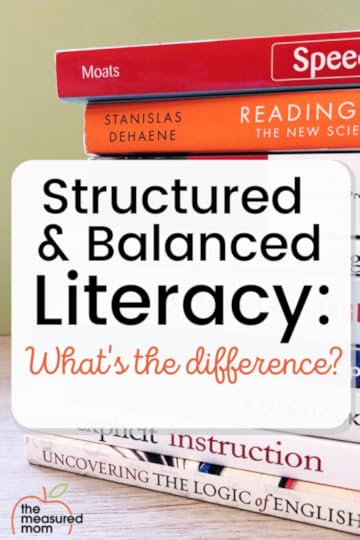
��
Balanced and structured literacy are two different approaches to teaching reading.
They have things in common, but when they’re referenced in the same breath they’re usually pitted against each other.
I considered myself a “balanced literacy” teacher for many years. It’s the approach I learned in graduate school, the approach I used as a classroom teacher, and the approach I (used to) teach on my website and in my online course.
However, after a great deal of research into the science of reading, I now see things differently.
I now advocate a structured literacy approach to reading instruction.
This isn’t to say that I did every single thing wrong as a balanced literacy teacher, or that balanced literacy teachers today aren’t getting anything right.
Nor do I think that we have to throw away everything with the balanced literacy label.
But it’s time to take a good look at what we’re doing when we teach children to read.
What’s the difference between balanced and structured literacy?Let’s start with a definition of balanced literacy.
Balanced literacy is a philosophical orientation that assumes that reading and writing achievement are developed through instruction and support in multiple environments using various approaches that differ by level of teacher support and child control.
Fountas & Pinnell – Guided Reading: Good First Teaching for All Ages
The fact is, if you ask twenty different balanced literacy teachers to define balanced literacy, you will likely get twenty different definitions.
It’s just not well-defined.
But most balanced literacy teachers will say (as I did) that they teach reading in a way that meets everyone’s individual needs while also promoting a love of reading.
Balanced literacy came about in late 90’s as an answer to the whole language and phonics debate.
The hope was that it would provide a much-needed compromise by using the best of both approaches.
To many people, though, balanced literacy is a dirty word.
What went wrong?
Why is structured literacy now coming into favor? Many will tell you that it’s just another pendulum swing. I think it’s much deeper than that.
Let’s start with a definition.
I used to be a STRONG balanced literacy advocate���The term ���Structured Literacy��� is not designed to replace Orton Gillingham, Multi-Sensory or other terms in common use. It is an umbrella term designed to describe all of the programs that teach reading in essentially the same way.���
Hal Malchow – International Dyslexia Association
Believe me, I never thought I’d be writing an article comparing balanced and structured literacy.
I believed in balanced literacy with all of my heart.
I became irritated very angry when I read articles that slammed balanced literacy.
The articles said I wasn’t teaching phonics (I was).
The articles said I was teaching guessing (I felt that I was teaching my students to be strategic).
The articles said I should be doing more explicit instruction (I felt that my mini-lessons served that purpose just as well as a 30-minute whole class lesson that would likely bore half my class).
The articles criticized my lack of a structured curriculum (I felt that I knew my students much better than a scripted curriculum any day).
The articles said balanced literacy didn’t work. I had plenty of anecdotal evidence that it did.
Here’s the thing. And this is something we all need to take note of.
Balanced literacy works for some children. Many children DO learn to read without a lot of explicit instruction.
But it doesn’t work for others.
Explicit instruction is good for all children. It’s absolutely essential for many of them.In other words?
If we use a balanced literacy approach, we will not reach all of our students.
Here’s the key difference between balanced and structured literacyBalanced literacy is centered around activities that surround children with quality literature and promote a love of reading, whereas structured literacy teaches the structure of language through explicit, systematic, sequential instruction.Balanced literacy teachers typically teach the essential components of reading (phonological awareness, phonics, fluency, comprehension, and vocabulary) through the following structures:
Read aloudShared readingGuided readingIndependent readingTeachers tend to be more focused on the activities themselves than on the skills.
On the other hand, structured literacy teachers may include read aloud, shared reading, small group instruction, and independent reading in their days, but they are focused less on activities and more on the structure of language:
PhonologySound-symbol correspondencesSyllablesMorphologySyntaxSemanticsA summary of the differences between balanced and structured literacyI know that not everyone will agree with my characterizations in the following chart, but this is how I see it:
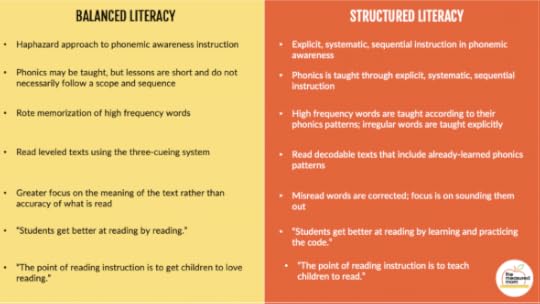 Let’s tackle the differences one by oneDifference #1In balanced literacy, we typically see a haphazard approach to phonemic awareness instruction.Structured literacy includes systematic, sequential instruction in phonemic awareness.
Let’s tackle the differences one by oneDifference #1In balanced literacy, we typically see a haphazard approach to phonemic awareness instruction.Structured literacy includes systematic, sequential instruction in phonemic awareness.Through the work of David Kilpatrick, we’ve learned that phonemic awareness may very well be the missing key for struggling readers. It’s essential that we give daily lessons in phonemic awareness.
Our students need lessons in phoneme isolation, blending, segmenting, and manipulation.
(If you’re a member of The Measured Mom Plus, check out my video series about phonological and phonemic awareness).
If you’re a balanced literacy teacher, an important change you can make is to do ten minutes of phonemic awareness instruction every day.
Try Heggerty’s easy-to-use curriculum (my top pick!) or the free lessons you can print at Reading Done Right.
I also recommend the hands-on games that you’ll find in my phonemic awareness bundle.
Check out our hands-on phonemic awareness activities!
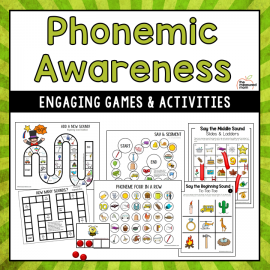
Phonemic Awareness Games & Activities
$24.00
You’ll get a thorough assessment along with meaningful games for teaching all levels of phonemic awareness.
Buy Now
Difference #2In balanced literacy, phonics lessons are typically quite short and may not follow a scope and sequence.In structured literacy, phonics is taught through an explicit, systematic and sequential approach (usually through a purchased curriculum).
As a new first grade teacher, I had to use a scripted phonics program that I HATED.
It moved too quickly for my low readers, and it was immensely boring for my strong ones.
And it took way too much time out of our school day.
I received permission to ditch that program in my second year of teaching first grade, and from then on I had a very “I’ll teach it when you need it” approach to phonics.
I’m fully aware that many balanced teachers DO have a structured approach to teaching phonics, and I say hurray for them!
But it’s not the norm.
A strong phonics lesson is 20-30 minutes long and has most, if not all, of the following components:
A phonemic awareness warm-up that connects to the phonics skillExplicit introduction of the new sound-spelling relationship Blending practiceWord buildingPractice reading decodable textGuided writing practice(And while there are still pretty boring phonics programs out there, there are many hands-on programs that allow you to meet multiple levels in one classroom.)
Difference #3Balanced literacy teaches rote memorization of high frequency words.In structured literacy, high frequency words are taught according to their phonics patterns, and even irregular words are taught explicitly.For years I thought it made perfect sense to teach kids to memorize long lists of high frequency words. That’s why I created a whole series of sight word books that taught high frequency words through repeated exposure.
I’ve since removed those books from the website because I’ve learned that this isn’t the best approach for teaching high frequency words.
Read: How to teach sight words
After all, kids don’t store thousands of whole words in their brains. That’s not how the brain learns to read.
A better approach is to teach a small number of “sight words” to get kids started (such as the and is), and to teach the rest when you teach their related phonics patterns.
As for irregular words, you can still be explicit about teaching them.
Check out the video below to learn about my new sight word lessons and accompanying decodable books.
Difference #4In a balanced literacy classroom, beginning readers read leveled texts using the three-cueing system.In a structured literacy classroom, early readers read decodable texts that include already-learned phonics patterns.This difference right here is the one that made me realize I could no longer support a balanced literacy approach.
If you consider yourself a balanced literacy teacher and do not teach your students to solve words using the picture, context clues, first letter (and anything else other than sounding out the word), please comment below … because as far as I know this type of teacher does not exist.
I never EVER thought I’d denounce three-cueing, but after studying the science of reading I can no longer support it.
If this makes you bristle (believe me, I know how you feel), I encourage you to listen to my podcast episode, What’s wrong with 3-cueing?
For years I resisted decodable books because I was sure they would kill a love of reading before it could start.
After all, wasn’t every decodable book boring, stilted, and nonsensical?
Turns out … I was wrong! There are actually many quality decodable books just waiting for you to discover them.
Difference #5In a balanced literacy classroom, there is typically a greater focus on the meaning of the text rather than on the accuracy of what is read.Structured literacy teachers correct misread words; they encourage their students to sound them out.This sounds crazy, but for years I believed that “sound it out” should only be said as a last resort.
I thought that it was much better to ask my students to consider what made sense … because isn’t reading all about comprehension?
(Well, yes it is, but reading comprehension is a product of decoding and language comprehension. See this podcast: What the science of reading is based on)
I think that the traditional use of running records leads many balanced literacy teachers to believe that getting the general meaning right is more important than sounding out every single word.
For that reason, I recommend rethinking running records.
Difference #6Balanced literacy teachers believe that students get better at reading by reading.Structured literacy teachers will tell you that students get better at reading by learning and practicing the code.This one is a little tricky. Kids need to practice reading, whether or not they’re in a balanced literacy classroom.
But first they need to learn to decode the words, which they learn through explicit instruction.
As a balanced literacy teacher, I had my students fill their bags with “just right books” (i.e. leveled books that required them to use three-cueing to solve the words) because I thought that they more they “read,” the more they’d pick it up.
Now I know that after kids have developed the habit of connecting the phonemes to the graphemes (sounding out words), reading practice will help them orthographically map the words (i.e. store them in their brains for future, instant retrieval).
Difference #7Balanced literacy teachers believe that the point of reading instruction is to get children to love reading.Structured literacy teachers believe that the point of reading instruction is to teach children to read.This is NOT to say that balanced literacy teachers aren’t concerned with teaching children to read.
Of course they are.
This is NOT to say that structured literacy teachers don’t want children to love reading.
Of course they do.
But structured literacy teachers understand something I didn’t “get” for a long time.
Success breeds motivation.*
When you teach children to read, and they see that they can do it … that they are actually pulling those words off the page by connecting the sounds to the letters, THAT is what gets them excited about reading.
*Heard in this podcast episode from The Reading League
Final thoughtsThis may be my longest blog post ever, so it’s time to wrap it up. Before I do, though, I want to address a few criticisms of each approach.
Critics of balanced literacy say that it’s haphazard, teaches bad habits, and puts the cart before the horse.
These criticisms were immensely insulting to me not so many months ago.
But now I get it.
By not teaching skills in an explicit, systematic way, I was missing many of them.
By teaching my students to use the picture or context to solve words, I was teaching them habits that would not serve them when they got into third grade (and the harder texts that came with it).
By thinking that we needed to focus FIRST on comprehension, I was putting the cart before the horse. (I was expecting them to comprehend what they couldn’t even read!) I had to teach them decoding first. Once their decoding became more automatic, they could develop fluency. Then comprehension came into play.
Critics of structured literacy say it’s boring and drill-and-kill. They claim that it stifles fluency, ignores comprehension, and kills the love of reading.
I’m not making this up. These were my criticisms of structured literacy.
Now I know that explicit, systematic teaching does not have to be boring. When a knowledgeable, engaging teacher combines the art of teaching with the science of reading, joyful learning can result.
Now I know that while it’s a little painful to hear kids sounding out every word (instead of flying through predictable texts), it’s a necessary part of the process. I learned that we can focus on comprehension when a child can sound out words quickly enough to remember what was read. Until that time, we focus on comprehension through interactive read alouds.
And through conversations with a principal, school psychologist, and many former balanced literacy teachers, I finally get it.
We’ve got to teach kids to read before they can love it.
The post What is the difference between balanced and structured literacy? appeared first on The Measured Mom.
April 4, 2021
What is structured literacy?
Are you here to get the details about structured literacy?
Let’s dive in!
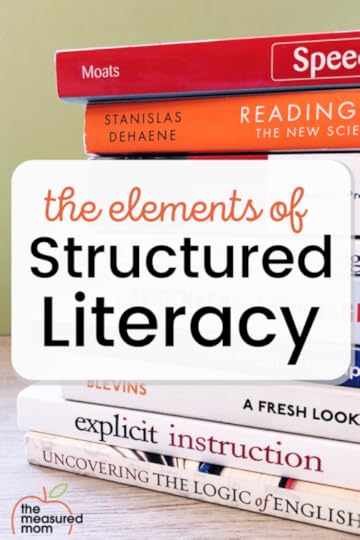
For years I considered myself a balanced literacy teacher.
And it’s not really a surprise. I was in college when balanced literacy came into existence (1996).
I entered the classroom during its heyday (1999).
And all the coursework I did for my master’s degree in Curriculum & Instruction (with a focus on reading) revolved around a balanced literacy approach.
So why am I here talking about structured literacy?I couldn’t ignore it anymore.
I wanted to, believe me. I was sure that structured literacy meant drill-and-kill, phonics only, cringeworthy decodable books, and tedious scripted curricula.
Everything I’d spoken against.
But guess what?
Turns out I was wrong.
What is structured literacy?Structured literacy was a term coined in 2016 by the International Dyslexia Association.
“The term ‘Structured Literacy’ is not designed to replace Orton Gillingham, Multi-Sensory or other terms in common use. It is an umbrella term designed to describe all of the programs that teach reading in essentially the same way.”
Hal Malchow, International Dyslexia Association
Structured literacy uses explicit, systematic teaching to teach the following elements:
phonologysound-symbolsyllablesmorphologysyntaxsemanticsWhat are those? We’ll get to that in a minute. But first …
Why do we need structured literacy?For years, I was convinced that structured literacy was overkill.
After all, my students had thrived with a balanced literacy approach (I thought).
My oldest five kids learned to read using a balanced literacy approach (I taught them to read before they started school).
What really opened my eyes was learning that while balanced literacy may be successful for some, it doesn’t work with everyone.
When I learned that about 40% of kids can learn to read no matter how you teach them, but that a greater percentage need a structured literacy approach, things started making sense.
That student I had that couldn’t read past level A no matter what I tried? She needed explicit phonemic awareness so she could sound out words.
That little boy I taught who listened with rapt attention to my read alouds but struggled to get words off the page? He needed systematic phonics with engaging decodable text.
That towering 16-year-old football player that I tutored during grad school? The one reading at a second grade level?He didn’t need what my co-teacher and I were giving him … a smattering of this and a smattering of that.
He needed someone to teach him the code.Have you seen the ladder of reading?
Nancy Young, an experienced educator and speaker with extensive knowledge of evidence-based approaches to teaching reading, did her research and found that many students need a structured approach to be successful readers.
As in, 60% of students.
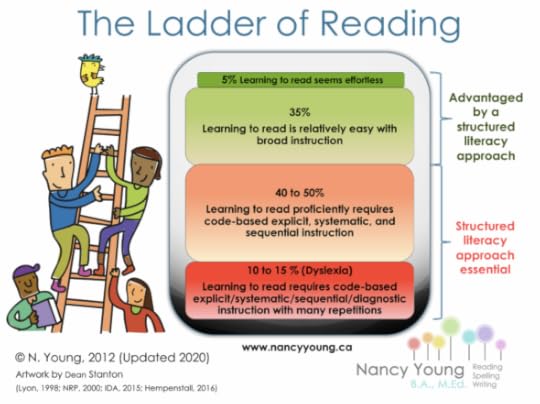 Used with Nancy Young’s permission
Used with Nancy Young’s permissionAs I (oh so reluctantly) learned more, I found that structured literacy does not need to mean boring.
It doesn’t mean that we kill the love of reading before it begins.
It means that we teach the essentials in a hands-on, engaging way.
What are the components of structured literacy?PhonologyPhonology is the sound structure of spoken words. It refers to phonological and phonemic awareness. Phonological awareness includes the ability to rhyme, count words in a sentence, and clap syllables.
Phonemic awareness is an important component of phonological awareness and involves the smallest parts of words: their individual sounds (phonemes). For example, in the word fish we have four letters but just three phonemes: /f/ /i/ /sh/.
Sound-SymbolThe fancy explanation of “sound-symbol” is mapping phonemes to graphemes.
If you’re looking for plain English, sound-symbol has to do with knowing what sounds go with which letters. For example, b is used to represent /b/. A more complex example is that igh is used to represent /i/.
(In other words … phonics.)
Sound-symbol is important for both decoding and encoding. Plain English? Reading (decoding) and spelling (encoding).
SyllablesHave you heard of the six syllable types?
open syllableclosed syllablesilent-e syllabler-controlled vowel syllableconsonant-le syllablevowel pair syllableI’ll be honest … I did not teach syllable types when I taught beginning readers. This felt boring and way more than they needed to know to be successful readers.
Little did I know that learning the six syllable types goes a long way in helping children read long, unfamiliar words.
MorphologyEnough with the big words already, right?
A morpheme is the smallest unit of meaning in a language. Morphemes include roots, base words, prefixes, and suffixes.
Believe it or not, we teach morphology in kindergarten. (When you teach kids that adding s to a word makes it “more than one” you’re teaching morphology.)
Of course, it gets more complicated as children move through the grades.
SyntaxSyntax has to do with the way we structure language to convey meaning. Syntax is all about grammar and sentence structure.
SemanticsSemantics has to do with meaning. When we teach semantics, we teach comprehension of written language.
What does structured literacy look like in the classroom?Great question!
I’m all about getting practical, and I won’t leave you hanging.
Today’s post was just a quick overview.
In the next month, Becky Spence (This Reading Mama) and I are going to get specific.
Stay tuned for the rest of our 7-part series!
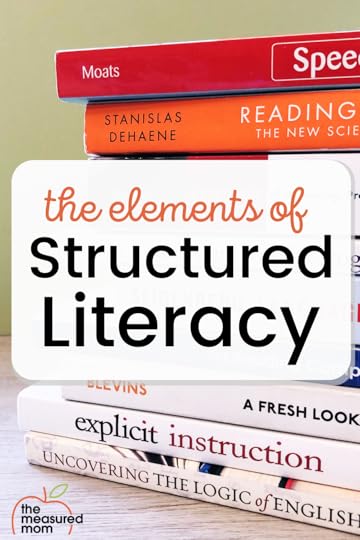 Part 1
Part 1
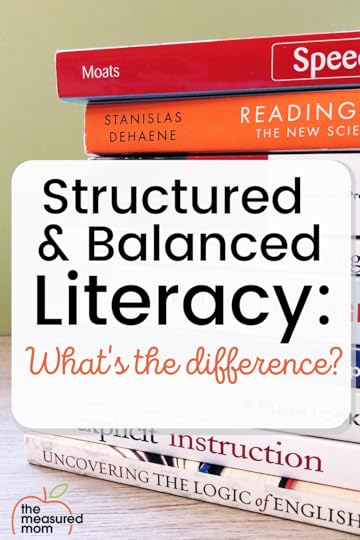 Coming soon
Coming soon
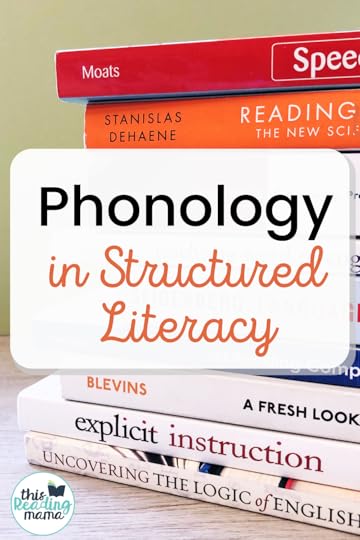 Coming soon
Coming soon
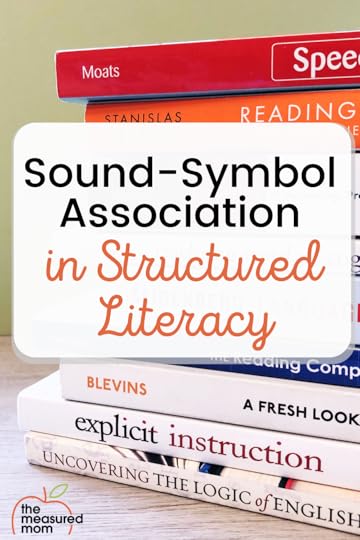 Coming soon
Coming soon
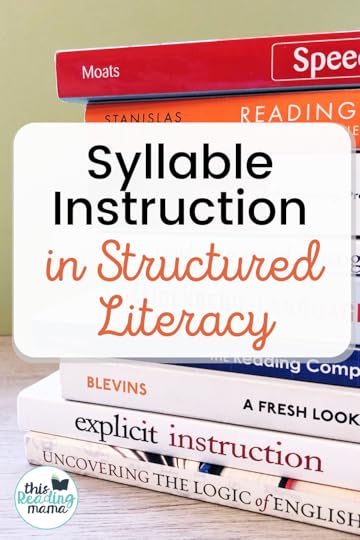 Coming soon
Coming soon
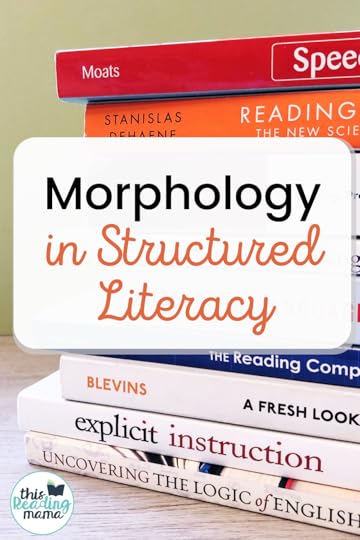 Coming soon
Coming soon
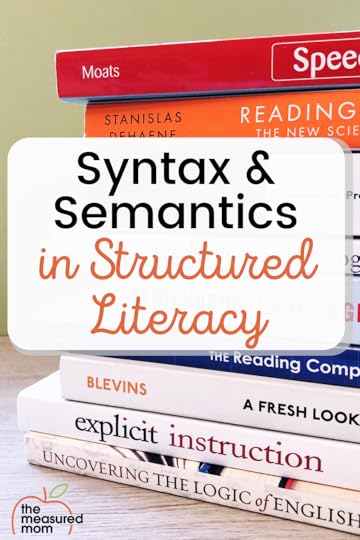 Coming soon
Coming soon
��
Recommended reading Effective literacy instruction (International Dyslexia Association) Structured literacy instruction: The basics (Reading Rockets)The post What is structured literacy? appeared first on The Measured Mom.
March 24, 2021
The ultimate guide to decodable books
So … how do you feel about decodable books?
I admit it. I avoided them for a long time.
I felt that decodable books were boring, stilted, and would kill a love of reading.
I preferred to use leveled books with beginning readers. I thought that if I taught them multiple ways to solve words, their fluency and comprehension would be better than if they learned to read using decodable text.
But I changed my tune when I studied the science of reading.
Despite what I’d learned in graduate school, I discovered that our brains must connect the sounds to the letters when solving words. Having kids solve words by using the picture or context clues can actually teach bad habits for later on.
The good news is that there are some amazing decodable texts that are exactly what new readers need.
If you’re looking for the best decodable readers, you’re in the right place!
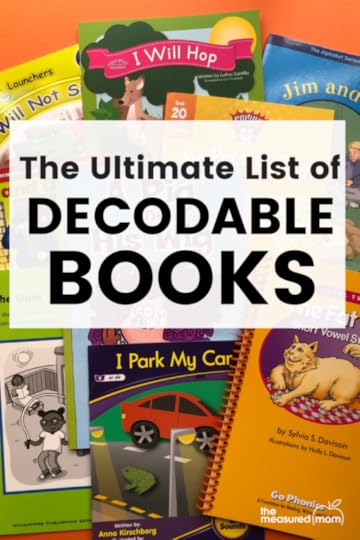
In this post I’ll share my favorite decodable books. I’ll also share some other choices that are not my favorite but are still popular with other teachers.
Finally, I’ll share some free decodable readers for those on a tight budget.
Favorite Decodable Books[image error]Half-Pint ReadersHalf-Pint Readers are fantastic for brand new readers. The books, created by a kindergarten teacher, are simple but engaging, and the books actually tell real stories with a problem and solution. The end of each book includes both simple and high level questions that build comprehension. Best of all, the books are affordable so you can easily purchase multiple copies.
Highly, highly recommended!
Great for: Level A is perfect for brand new readers who are just starting to sound out words. Level B introduces blends, digraphs, and simple word endings. Level C features long vowel sounds and more blends and word endings.
Price: Very affordable! Consider purchasing multiple sets for reading with small groups.
Get Half Pint Readers here [image error]Reading for All LearnersWe used the I See Sam books (Set 1) a lot when my little guy was first starting to read words. They start very, very slowly … gradually adding letters and sounds, and with very few words on each page.
The stories would not make sense without the (wonderful) pictures, because the text can feel rather stilted. “See Sis sit in it. See me. See me sit in it.” I can overlook the stilted language, though, because the pictures allow for wonderful discussion, and they truly are adorable.
Great for: Set 1 is perfect for brand new readers, but with six sets that get progressively more difficult (and 141 total books), you can go a long way with these.
Price: Very affordable! Go even less expensive and get the black and white editions.
Get Reading for All Learners books here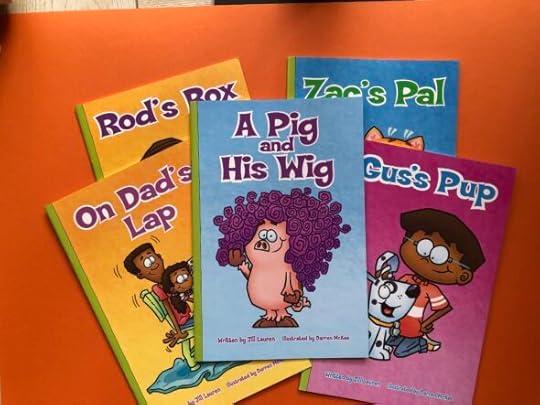 Whole Phonics
Whole PhonicsIf decodable books have a bad name, Whole Phonics will redeem it. The stories are creative and funny, and the pictures are the best I’ve seen. My only issue is that the verb tenses often switch (a pet peeve of mine), but the stories are so good I can overlook it.
The books are on the longer side, so you may want to start with a simpler set or read a book in more than one sitting.
Great for: Older struggling readers and kids who are past the very beginning stage (but still learning to sound out words).
Price: These are high quality books with a price to match (around $5 a book). Keep in mind, though, that these are full color, well-developed stories and worth every penny.
Get Whole Phonics books here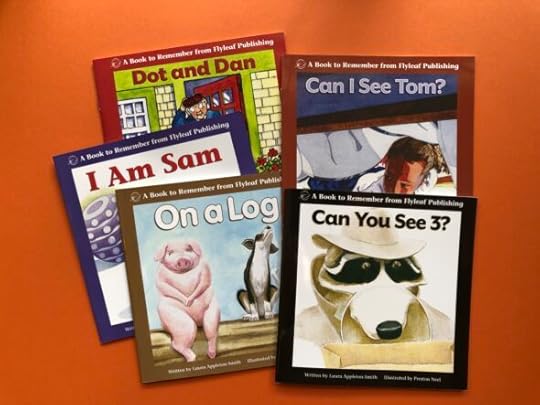 Flyleaf Decodable Books
Flyleaf Decodable BooksThese are the loveliest, highest quality decodable texts that we own. They are also on the expensive side, but definitely worth a purchase. The books advance rather quickly, and there aren’t a lot of books for each pattern, but you will love having them in your collection.
Great for: Kids who are advancing quickly. The books are incredible, but there are only a few for each stage.
Price: These are high quality books and priced accordingly, at about $4 a book. (When you think about it, that’s still a great price, but you need so many decodable books for beginning readers … and the cost adds up fast.)
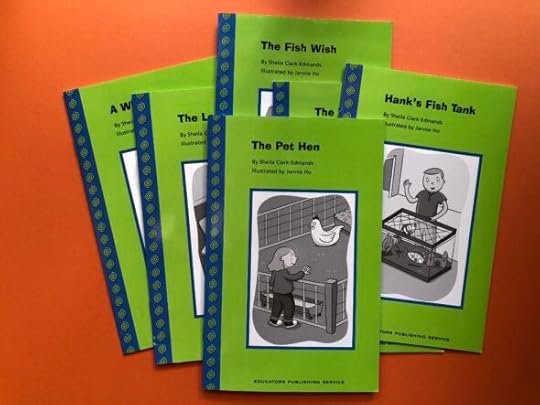 S.P.I.R.E.
S.P.I.R.E.This is a wonderful series of 120 books. I love that even the simplest stories have interesting plot lines. The books slowly advance, adding new phonics skills through six levels.
The illustrations are black and white, but they are still engaging.
Great for: Both brand-new readers and kids moving at a faster pace
Price: The books are just under $4 a book, which feels a little pricy for black-and-white readers. But the stories are high quality, so I think it’s worth it.
Purchase S.P.I.R.E decodable readers here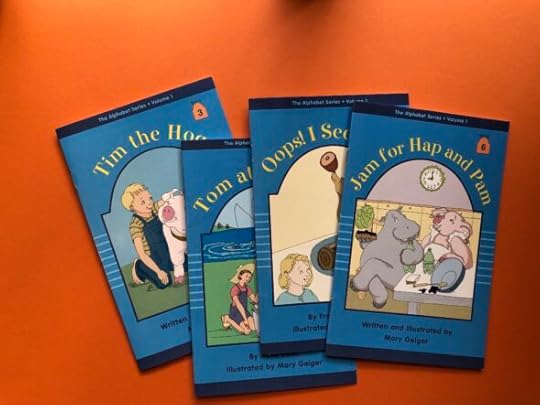 The Alphabet Series
The Alphabet SeriesThis is another high quality series that slowly adds new sound-spelling correspondences with each book. Don’t let the black and white interior illustrations fool you … these are interesting stories with funny pictures.
Absolutely one to own, and a great choice for small group lessons!
Great for: Both brand-new readers and kids moving at a faster pace
Price: The price varies, but I was able to find them for about $3 a book (linked below).
Get Alphabet Series books here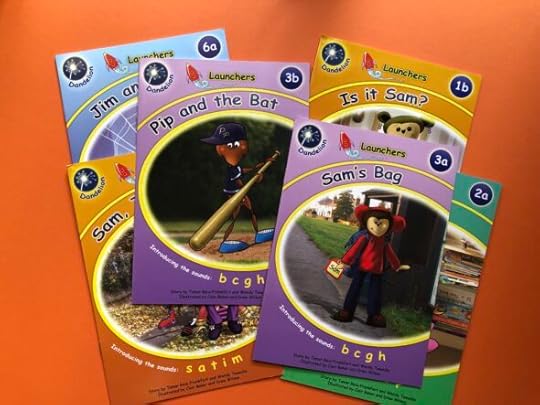 PhonicBooks
PhonicBooksThese are a favorite of many reading teachers. For the first books, kids only need to know a handful of letter sounds. The books have a unique illustration style (photographed backgrounds with cartoons drawn on top). The early books are very, very short — making them a great choice for brand new readers.
Best for: All levels! The early books are ideal for brand new readers, but PhonicBooks has a variety of series, including books for struggling readers up to 14 years old!
Price: The Dandelion Launchers (pictured above) are sturdy, full-color books for about $3 each.
Get PhonicBooks here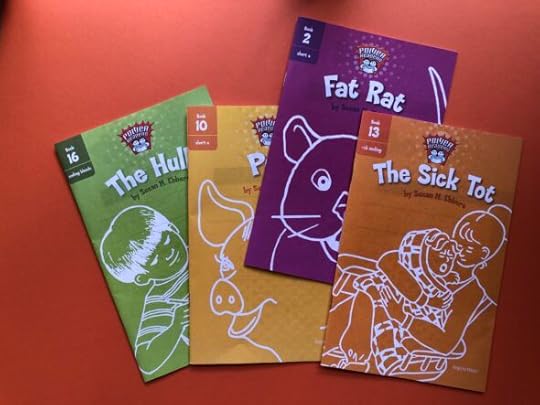 Power Readers
Power ReadersSusan M. Ebbers’ power readers are incredibly affordable because they are made of thin paper and are meant to be disposable. That’s because the front of each book includes (quality) worksheet-type activities that students can do to prepare them for reading. Even more activities are in the back, including comprehension questions.
Great for: Teaching beginning readers in small reading groups (Before and after reading activities are built right into the books!)
Price: Since these are flimsy, write-in books, they are just over $1.50 each.
Get Power Readers here [image error]Go PhonicsGo Phonics offers spiral bound decodable books with multiple stories in each book. The stories are funny and hilariously illustrated (though black and white).
My little guy has read the simplest book (the tiny one pictured in the center of the pile above) at least 15 times!
Great for: Using as reading books for small groups; turn to a new story for each lesson. Or use them for homeschooling since each book contains multiple stories. Start with short vowel stories and move up to words with long vowel pairs.
Price: On the pricey side; All 7 phonics readers cost $127.00. You can buy individual readers for about $19 each. They are high quality and sturdy.
Get Go Phonics readers here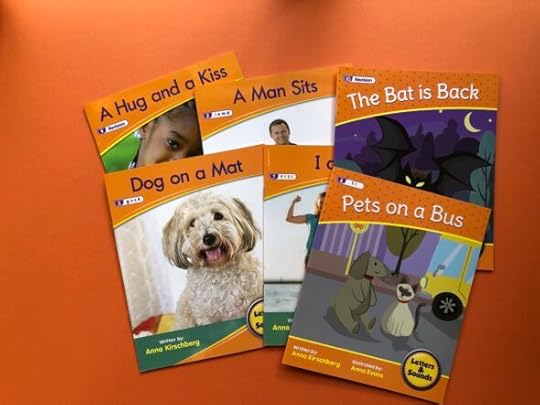 Junior Learning decodable books
Junior Learning decodable booksI wavered about whether or not I should include these in my favorites list because the quality varies so much. The illustrations and physical quality of the books are always good, but some of the stories are so bizarre and contrived that it was impossible to have a good conversation about them afterward. And yet … so many good ones too! You certainly can’t beat the selection.
Great for: Beginning readers and learners with advancing skills
Price: Extremely affordable; you can often get them for around $2 a book. A good thing, since in a set there may be several books with such odd storylines that you won’t want to use then.
Get Junior Learning books here Other Decodable BooksPrimary Phonics are vintage decodable books that are quite popular. I can’t in good conscience put them on my favorites list because I really didn’t like them. In fact, I purchased the full set and returned them after previewing them. The stories were strange and hard to follow, and because the books are almost 100% decodable, the stories are very stilted. I appear to be in the minority, however; many people love these books.
BOB Books are another popular choice, likely because they are so affordable and so easy to find. I don’t care for the stilted language (“He did get it”), and the illustrations leave much to be desired. But they will do the job.
Dog on a Log books look strange to me; the author has taken public domain images and slapped them together. The sample books I have read do not appeal to me, but many people say that their learners with dyslexia love Dog on a Log books and report great success using them.
Little Learners Love Literacy are decodable books from Australia. I haven’t used them, but they look fantastic … such great pictures!
Spalding has a variety of decodable books that look promising.
High Noon offers decodable books that are appealing to older learners.
Reading A to Z is mainly a source for leveled books, but they do have a decent decodable section.
Simple Words offers decodable chapter books.
Apparently Geodes has amazing decodable texts. My guess is that they are quite pricy.
SuperBooks are vintage decodable books that have a special charm. The stories are often interesting, though the text can feel stilted. You cannot beat the price; these are sturdy, full-color books for just over $1 a piece.
Free decodable booksCore Knowledge has free decodable readers that you can read online. They’re absolutely lovely! You do need to do a little digging to find them.
You can get free Measured Mom Nonfiction Decodables right here on this website. Just click here to view and download.
You can also check out my decodable books that feature high frequency words. Each free book comes with a lesson that explicitly teaches a high frequency word. Find them here.
Starfall has free decodable books that you can print. (You can also purchase full-color editions.)
Have you seen our short vowel decodable passages?
[image error]
Decodable Passages: CVC Words
$5.00
This affordable set features 23 passages to help new readers develop fluency with CVC words. Each page includes blending practice, a short reading passage, a comprehension question, and spelling practice.
Buy Now
The post The ultimate guide to decodable books appeared first on The Measured Mom.
March 21, 2021
Should you use leveled or decodable books with beginning readers?
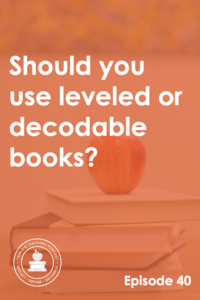
Leveled books are predictable books with strong picture support.��Decodable books feature words whose sound-spelling patterns have been explicitly taught. Which are best for beginning readers?
Listen to the episode hereFull episode transcriptTranscript
Download
New Tab
Hello! Anna Geiger here and I am joining you for another Facebook live video, which is going to become Episode 40 of the Triple R Teaching podcast. In this episode, we're going to talk all about decodable and leveled texts. Should you be using decodable books or leveled books with your young readers?
Last week, we talked about three-cueing. That was an episode that was hard for me to prepare and give because over the years I have relied on three-cueing when teaching young readers to solve words, but now I've learned that it is not the best approach for several reasons. Having kids solve words by using context clues or pictures, or just the first letter, is not a good idea because we're actually training them to do their reading work on the wrong side of the brain. Instead, we want them to do the reading work on the left side. We want them to connect the phonemes to the graphemes - the sounds to the letters, because scientists tell us that that's how kids are able to take what they're getting off the page and make it a part of their permanent sight vocabulary. That is words that they can recognize instantly, just like you recognize thousands and thousands of words by sight. You're not sounding out every word as you read, and that's where we want our students to get. In order to get there though, they have to sound out the words at first.
I know that as a teacher, I thought that I was doing it all correctly because I did teach phonics - we had phonics lessons. The problem is that when I moved my kids into their guided reading groups, I was using books that did not require them to use their phonics knowledge. Here's a quote from Wiley Blevins, "When students are mainly reading leveled text with predictable sentence structures, they're undervaluing and underusing their phonic skills." This creates a really bad habit. Every book they pick up, their first strategy is to try to look at the patterns, look at the pictures, or memorize. Decodable books encourage the right strategy of sounding out the words."
Now, if you're like me, you are very hesitant to switch from leveled books to decodable books. Today I want to talk to you very briefly about the difference between the two and why I believe decodable books are a great choice for beginning readers.
Leveled books typically use predictable patterns, and they require children to use pictures and context clues to solve many of the words. Because the books are predictable, a lot of times they see the same sight words or high frequency words over and over so that for some children, seeing them over and over allows them to remember those words. It doesn't work for everyone.
Here's an example of a leveled book. It's called, "My Map", and it says, "I made a map. I made streets. I made a house. I made a stop sign." You can see how that book is very predictable, and that if children can very quickly learn the pattern, "I made ___. I made____," then they can use the pictures to solve the words. Or for parts of the words they can use phonics.
For example, if someone is trying to read, "I made streets", they may not know that the word is streets, but if they look at the picture, they could say, "Oh, okay, I made s-streets". They could maybe figure it out, but you can see how there's a lot of guessing that has to happen. They probably don't have the phonics skills at this early level to sound out the word "streets" and particularly the word "house" on the next page. Most kids at a very early reading level don't know that "ou" spells /ow/. So in having kids use these leveled books, a lot of times what's happening is that they're developing habits of guessing instead of paying attention to all the letters in the words.
Now I use leveled texts for many years. I used them with my oldest kids when teaching them to read, and I did not believe that leveled texts were harmful because my kids could learn to read with them! I taught them some phonics and they were able to apply it to a lot of the other books they read. The problem is that many kids don't do that very well, and everyone will benefit from learning how to sound out words, because this will serve them as they get into higher levels of reading.
Many teachers tell us that they teach kids in third grade or higher and their students have learned those habits of looking at the pictures and thinking about what would make sense, instead of actually paying attention to the words themselves, and that at that age they hit a wall. Reading becomes very difficult, and when they try to read those longer words in their social studies or science textbooks, they don't have strong enough phonics skills to attack those words and then they have a problem.
So that's why with our youngest readers, we've got to put more focus on decodable text. Now, a decodable text is different for every child because a child beginning kindergarten is able to sound out something very different than someone who's in second grade, right? It depends on the phonics skills they've learned, so a book may be decodable for one child and not for another. It just depends on where they are in their phonics knowledge.
The definition of a decodable book is a book that contains phonics patterns that a child has already learned. Now is every single word in a decodable book decodable? Personally, I hope not because that means that kids aren't going to have words like, "the", and "of" that are really essential for making the sentences flow and making the text make sense. There are some authors of decodable books that have created them to be 100% decodable on purpose. I think that can be a problem, but I do think a substantial percentage should be decodable, maybe 60-80% on the high-end.
Now, if you're like me, you're thinking I don't want to use decodable books to start teaching early reading because they're boring, they don't sound right, and they're going to kill a love of reading. Those are things that I felt for a very long time. To be honest, it's probably fair that I thought that because the decodable books that came with my phonics series were really pretty bad. They were very small, all black and white - which doesn't have to be a problem, but the pictures were not engaging. And because the authors were so eager to make the books completely decodable, they had very stilted sentences and they just didn't sound right! They used words the kids never even heard of just to try to fit enough to decodable words in the text, so that comprehension really wasn't going to happen with those texts. I found them to be painful and a waste of time.
I have two things to say about that, however. Number one, there ARE quality decodable texts, and we're going to get into that. But number two, when you feel that what you're using really is important, you will do a better job with it. You will be more excited about it, and so will your students! So if you have a decodable text that you think, "Ugh, this is so boring and it doesn't make any sense at all. I hate it, but I guess I have to use it." It's going to show, right? So you need to educate yourself about why decodable books are helpful and you need to find good ones, and then you can use them with your students.
Next week, we're going to talk about how to find good decodable texts, like what are the qualities of a good decodable text, and I'm going to share with you my favorites. I just want to really quickly give you a comparison.
A few minutes ago, I read you an example of a leveled text. Here's a decodable text, I'll go ahead and start with one that I wrote. This is called, "I Camp". This would be a book for kids who can read CVC words and words with beginning blends and digraphs. It says, "I get my bag. I go on a path. I look at a map. I set up the tent. I sit and sip. I like to camp." So in this book, the words are very decodable. There are a few sight words that you'd want to teach like the words "to", "the", and "my", which maybe are not phonics patterns that the child knows yet, but overall, they can sound out the words.
And you could ask questions about this book! You can say, what does the boy do when he goes camping? Why do you think he's looking at a map? I think you want to make sure that the decodable texts you choose actually have something that can be discussed! If it's a whole bunch of random sentences, just to get lots of phonics practice, then you're probably better just reading random sentences than reading them in a book. When we read a book, we should be able to identify what it's all about and answer questions about it. If it's just random words, then we may also be doing a different kind of damage to our students. We may be teaching them that reading doesn't have to make sense.
As I talked about last week with three-cueing, while we don't want kids to use the three-cueing method to solve words, we do want them to monitor. If they're reading a word and they finish the sentence, and it sounded funny or didn't make sense, we want them to go back and read it again and correct it. So first they're sounding out the words, but we want them to be able to go back and correct. If it's a phonics book or decodable book that mixes up word tenses all the time and is very awkward - because the authors don't want to use certain words - then kids can't self-correct because it all sounds strange!
I also, before we close today, want to talk to you a little bit about leveled books and if there is a use for them in the primary classroom. So I've told you before that in the past, I taught reading using leveled books, and those would be the Fountas and Pinell guided reading levels, typically from A and up. My very early readers would use very predictable books and use pretty much only picture cues. As they moved further along, they would use more phonics cues as they could.
I no longer believe that those are a good choice for beginning readers because you've really got to teach kids the HABIT of sounding out words. That is so important and you want them to be able to always look at the words first, and then look at the picture second. When I started teaching my youngest to read a few months ago, I started teaching him the way I taught his older siblings, where I taught with leveled texts, and I noticed that his eyes were jumping off the words. As soon as he figured out the book's pattern, he was looking just at the picture, and he wasn't looking at the words at all!
At that same time I was starting to read a lot about the science of reading, and I decided right away I would try something different. I would make the shift and I would just use decodable books with him. As he started using decodable books, it was just very different. Instead of opening the book and going right to the picture, his eyes would go directly on the words. He would sound them out, and then when he was done, he would study the pictures and ask me questions about the book. So he has learned that the text is where we start, and I think that's really, really key!
Now you may be resisting this idea of decodable texts because you might be thinking, well, how long do we have to do this? Is that all my students can read? That sounds boring! I have wrestled with this for a long time, and here is where I've landed. I think that kids should be using decodable texts in reading instruction until they have a strong phonics knowledge and for sure until they solve words by reading them - by looking at the letters - not by looking at pictures and thinking about what would make sense.
If you notice that kids are switching to leveled texts, but now all of a sudden are not using the phonics skills they've learned, then you need to go back to decodable text. Some teachers will tell you that kids should be in only decodable until second grade, and some will say maybe spring of first grade. It concerns me a little bit thinking about going all the way to second grade, but there may be students for whom that is necessary. If you're thinking that is going to kill the love of reading, if that's what they have to read, I encourage you to think about it in a little bit of a different way as I have been - the thing that builds a love of reading is success with reading.
If you are giving kids leveled books where they have to use pictures and they have to use context to solve the words, they know they're not really reading them because they can't read the words in isolation. It's hard to build confidence with reading that way. On the other hand, if you give a kid a very simple book that they can sound out with success, and they get faster and better, that's where the love of reading comes, with knowing they can do it!
There are lots of good decodable books out there, and we're going to get to those next week. If you have any questions, leave them below this video on Facebook or in the podcast comments. When the podcast is published you can find it at themeasuredmom.com/episode40. Thanks for joining me! Next week, we'll be talking about how to find the best decodable books for your learners.
Scroll back to top
Sign up to receive email updates
Enter your name and email address below and I'll send you periodic updates about the podcast.
powered by
Link to original Facebook Live presentationVideo presentationRecommended podcastsA Simple Look at How the Brain Learns to ReadWhat The Science of Reading is Based On
The post Should you use leveled or decodable books with beginning readers? appeared first on The Measured Mom.
March 20, 2021
How to teach sight words
I receive many emails from teachers and parents asking me how to teach sight words.
Are you here to learn how to teach high frequency words? You’re in the right place!
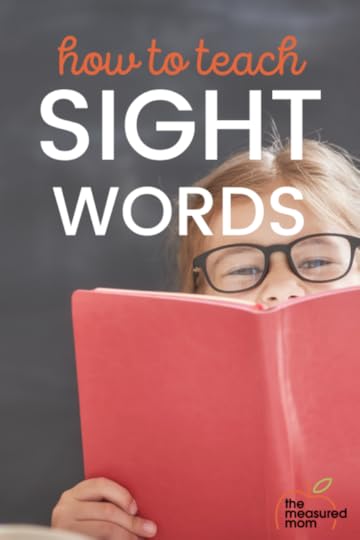 What are sight words?
What are sight words?Traditionally, when teachers say “sight words,” they are referring to high frequency words that children should know by sight.
We often define sight words as words that kids can’t sound out – words like the, for example.
However, reading researchers have a different definition of sight words.
A sight word is a word that is instantly and effortlessly recalled from memory, regardless of whether it is phonically regular or irregular. A sight-word vocabulary refers to the pool of words a student can effortlessly recognize.
David A. Kilpatrick, PhD
So should we get lists of sight words and get our students to memorize them using flash cards?
Not so fast.
This doesn’t fit with how the brain learns to read.
We are not trying to get students to cram pictures of words in their brains, because there’s a limit to how many words any of us can remember by sight.
How does the brain learn “sight words”?Researchers have discovered that strong readers do not call upon thousands of pictures of words in their brains. Instead, they (very, very quickly) connect the letters to the sounds in each word. They do this so quickly and effortlessly that it takes a tiny fraction of a second to identify each word.
How?
How do we move from sounding out words letter by letter, to recognizing thousands and thousands of words instantly?
It’s through a mental process called orthographic mapping.Say what?
Stick with me … I promise it’s not as complicated as it sounds.
Orthographic mapping is the process we use to store printed words in long-term memory.
David A. Kilpatrick, PhD
In order for us to read words and then store them for future retrieval, we must be able to match the phonemes (sounds) to the graphemes (letters).
Does that sound familiar to you?
It’s phonemic awareness and phonics.
We need to teach children to identify individual sounds in words and then connect those sounds to letters. We teach them to sound out words, even sight words.
What about sight words that aren’t regular, like the?We call attention to the parts of the word that are phonetic (and there���s usually at least 1-2 of them). Then we teach learners to learn the tricky parts by heart.
So what does this tell us about the big sight word lists … like Dolch and Fry?I don’t think it’s wrong to teach kids to read words using those lists as a reference, but we need to approach it a different way.
We shouldn’t be sending home lists of 50 “sight words” for our kindergartners to master.
Instead, we should integrate those words into phonics lessons as often as possible.
For example, the Dolch primer list includes words like these:
on, at, did, that, ran
Each of those words is perfectly decodable, and rather than teach them by sight, we should teach kids to read them using their phonics knowledge.
When we give then opportunities to sound out the words when reading them, we are providing an environment for orthographic mapping to take place.
Is there ever room for teaching kids to memorize high frequency words?Yes, but only a small amount (think 10-15 words), and only to make our students’ early reading material readable.
For example, a good decodable book (that actually sounds like a story) will need words like the. You will need to teach early readers to recognize the word the. And yet you can STILL call attention to the “th,” which is not irregular at all.
How to introduce sight wordsAssuming your learner has phonemic awareness and letter-sound knowledge, you’re ready to begin. (Not sure about the phonemic awareness? Give this free assessment.)Name the new word, and have your learner repeat it.Name the individual phonemes (sounds) in the word. For example, in the word is, there are two phonemes: /i/ and /z/.Spell the sounds. Call attention to any unexpected spelling. In is, we spell /i/ with i and /z/ with s.If possible, have your learner read related words. Has and his are great words to read alongside is because they are short vowel words with an s that represents the the /z/ sound.Have your learner read connected text. Connected text can be decodable sentences or books.More resources for learning about high frequency wordsFree lessons and decodable books for teaching high frequency wordsA new model for teaching high frequency words – Reading RocketsHeart Word Magic – Really Great ReadingTeaching Every Reader (online course)Essentials of Assessing Preventing, and Overcoming Reading Difficulties, by David A. KilpatrickThe post How to teach sight words appeared first on The Measured Mom.
Rethinking running records
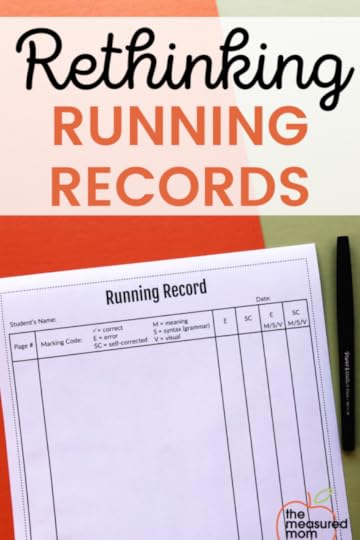
In the past I was a strong proponent of running records. I used them every day as a first and second grade classroom teacher, and as an online educator I’ve often promoted their use.
I felt that a running record – a visual representation of a child’s reading – was a wonderful tool to see exactly where readers were struggling and to know where to take them next.
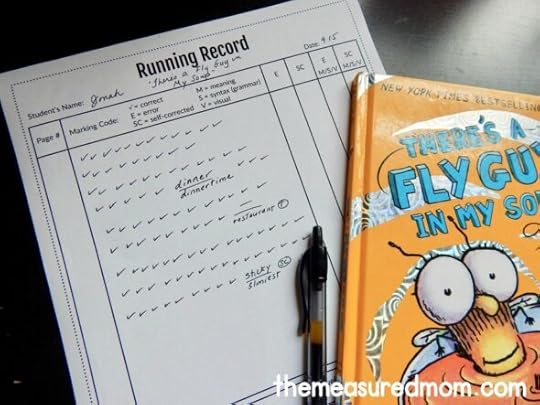 A traditional running record
A traditional running recordBut now that I’ve adopted a more structured approach to early literacy (after my research into how the brain learns to read), I believe we must reconsider running records.
Running records are still popular todayMany teachers are required to administer running records, and many choose them all on their own (I did!).
They use the results to group children for reading instruction and to guide students to a particular level when they read independently.
Should we still be using running records?
Why I didn’t want to let go of running recordsAs a teacher, my favorite thing about running records is that they were quick and efficient. I could do them anywhere!And I did! I used them daily during conferences when I listened to individual readers. I used these informal running records to get a quick visual of my students’ errors.
I could also get a quick picture of how fluently my students were reading. And when they answered questions about the text, I could jot down notes about their comprehension on the back of the page.
Why we should reconsider running recordsIt does not give me pleasure to reconsider running records. I LOVED them.
However.
The biggest issue that I see is the way that running records require us to analyze “miscues” (errors) using the three-cueing system: meaning, syntax, and visual cues.
The idea with running records is that we are to note whether students made a meaning, grammar, or phonics error when reading.
The problem with this is that we now know that the brain learns to read by connecting phonemes (sounds) to graphemes (letters), not by using meaning or grammar cues to solve words.
(See podcast episode 37: How the brain learns to read)
If we are giving kids text with words whose sound-spelling patterns we’ve taught them, they won’t need to use pictures or context to solve words.
And we shouldn’t want them to.
Novice readers need to focus on matching sounds to letters and sequences of letters so that they can literally identify words and begin to store then in their brain for instantaneous retrieval, i.e. “map” them orthographically.
Breaking the Code
Do you see the issue? If you are teaching kids to sound out words using the phonics patterns you’ve explicitly taught, then that is what you should be measuring … not whether they are using context or other clues to solve words.
Traditional running records don’t tell us what we truly need to knowIf your school teaches reading using a phonics program, measuring progress with this tool is a total mismatch.
Jocelyn Seamer Education
What you really need to know is how proficient your readers are with phonemic awareness. A running record can’t tell you that. (Try the free PAST Test instead.)
What you really need to know is how solid your students’ phonics skills are. A traditional running record only has columns for meaning, syntax, and visual cues … not a place to analyze specific decoding errors. Use an assessment that comes with your phonics program, or this free one.
What you really need to know is whether or not your learner is reading at an appropriate rate. While reading rate doesn’t determine whether or not a child is a strong reader, a low rate can be an indicator of other issues. Many teachers use DIBELS.
Should we throw running records away?Even if that were my recommendation, you may not have a choice. Let’s discuss how to make running records into a useful tool.
First, make sure that the text you use matches what would be used in a solid instructional approach.
Instead of assessing student reading on leveled text that requires the use of pictures and context clues, assess the reading of a quality decodable text that features sound-spelling correspondences you’ve taught.
Instead of marking whether students attended to meaning, syntax, or visual cues, note specifically what decoding errors were made.
Is the reader solving CVC words fluently? Or is s/he mixing up short o and short u?
Is the reader struggling with specific high frequency words that could use extra attention?
Is the reader using what you’ve taught about solving multi-syllable words?
Make other helpful notes in the margin.
Is the reader jumping to the pictures first when solving words? This is valuable information, because you’ll want to correct it. Make a note.
Is the reader sounding out words incorrectly and not self-correcting, even when it doesn’t make sense? Make a note.
Is the reader neglecting to read with attention to punctuation marks? Make a note.
Can the reader answer your questions after the reading? Make a note.
Final thoughtsIf you have the time, I believe that sitting and listening to a child read one-on-one is invaluable.
While I no longer believe that the traditional running record is a good assessment tool, an adjusted running record form could be useful.
You just need to know what text to use, what to listen for, and how to use your observations to address concerns.
Quotes in this post
Jocelyn Seamer Education – Time to Break up with Running RecordsBreaking the Code – Why Running Records and Leveled Readers Don’t Mix with PhonicsThe post Rethinking running records appeared first on The Measured Mom.
March 19, 2021
How to teach a child to read
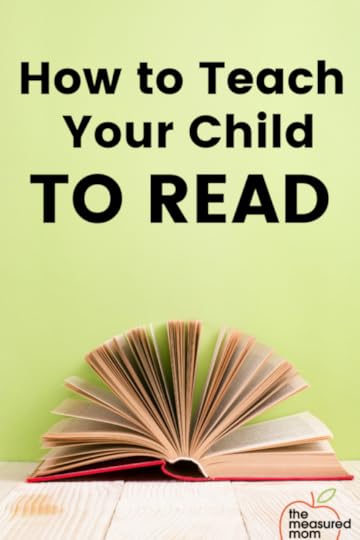
Are you wondering how to teach a child to read? This short blog post and free ebook will get you started!
I get many emails from parents wanting the answer to this question: How can I teach my child to read?
It often takes me weeks before I reply to their message, because the answer is such a big one. For that reason, I decided to write this ebook.
In it, you will learn the following:
The essential components of effective reading instructionThe pre-reading skills your child needs before you begin teaching him/her to readHow to teach phonics to kidsWhy it’s important that young readers begin reading with decodable textHow to approach “sight words”How to build vocabulary and language comprehension through interactive read aloudsTips for building fluencyHow to be an effective reading coach for your childA recommendation for a daily teaching scheduleJust enter your information below to join our email list, and we’ll send the ebook right to your inbox!��
Inside, you’ll find everything you need to get started with teaching your child to read at home.
Other helpful posts on this websiteTeaching preschoolers to read5 things kids need before they’re ready to sound out words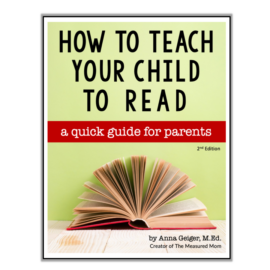
Get your free guide!
CLICK TO DOWNLOAD
The post How to teach a child to read appeared first on The Measured Mom.
Anna Geiger's Blog
- Anna Geiger's profile
- 1 follower



